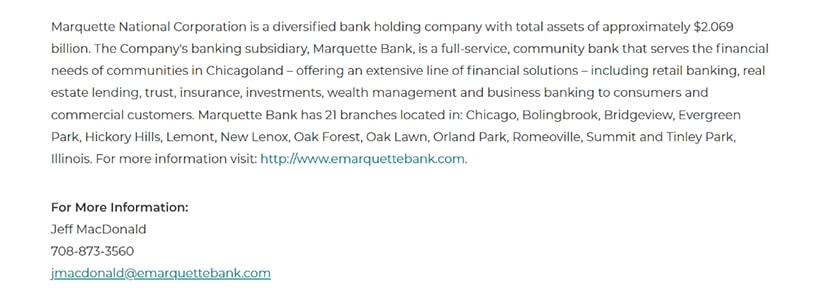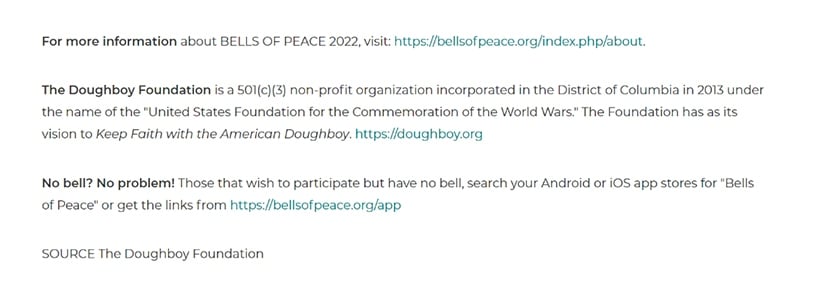A boilerplate is a one-paragraph company description at the very end of your press release, along with your contact details for more information. To write your press release boilerplate, determine your angle, describe your business, and add a call to action and contact information. Keep reading to learn more about how to write a boilerplate for your press release. Plus, download our free template and check out some boilerplate examples to get started.
Press Release Boilerplate Template
Download our free boilerplate template to help create an effective press release boilerplate. It follows the industry standard formatting; hence, you’ll only need to customize it with your information.
What is a press release boilerplate? A boilerplate in press releases is the “About” section at the very end of your document that gives background information about your business. It’s the section of your press release that helps promote your brand presence the most by telling readers key details and highlights about your company.
Need a primer on all things press releases? Read our guide first detailing what is a press release, and check out the 16 main types of press releases.
1. Identify Your Angle
A boilerplate is a concise description of your business, but it can be written in several ways, depending on your audience and what you want to achieve. For example, your angle might be to showcase or highlight specific information that aligns with your business goals or brand image. It could also be about its longevity, your company culture, investors and funding rounds, or recent accolades or accomplishments.
While all these are interesting, decide what is most important for your business and build your boilerplate copy around that. Here are some common angles for boilerplates and strategies that can help you achieve your goal:
Goal | Strategy |
|---|---|
Attracting investors | Include financial information like past earnings, projections, or growth statistics |
Increase brand awareness and affinity | Include your company’s guiding principles, mission, vision, or charitable endeavors |
Generate sales | Reference one or more of your company’s most popular products or services and link to a product page or landing page |
Build authority and trust | List key awards, accolades, or prominent company officials |
Show industry or thought leadership | List patents, breakthroughs, or industry disruptions |
Increase event attendance | Reference previous events’ statistics such as popularity, demand, or celebrities in attendance |
Increase participation | List deadlines or supply limitation to appeal to fear of missing out (FOMO) |
Earn media coverage | Include a link to multimedia assets and a media contact |
The right angle for your press release boilerplate might be the same as the overall angle for your story, but this won’t necessarily be true in all cases. For example, the purpose of a new hire press release could be to build credibility within an industry, while the boilerplate might target potential investors by highlighting the growth trajectory of the business.
To learn more about developing an angle for your press release, read our article detailing how to write a press release.
2. Write a Description of Your Business
To clearly and concisely communicate what your business does, start by writing a brief, one or two-sentence paragraph describing it. For example, write your main company description in just one sentence using this structure: “<Business name> creates <offering> to help <target audience> <solve a specific and significant problem> with <differentiating characteristic>.”
Once this part of the description is written, add compelling details based on your angle about your business’ impact, revenue, growth, and relevance. Also, you want to be certain that if a journalist only reads your boilerplate, they have all the important information they need to provide additional coverage of your story.
Here are a few questions to help you write your business description, depending on the angle you identified in step one:
- What industry is your business in?
- What does your business do?
- Who does your business work with?
- Where is your business located?
- When was your company founded?
- What size is your company (such as in terms of employees, revenue, and regions served)?
- Have you received any awards, commendations, or recognition?
- What is your market share?
- What are the biggest challenges faced by your ideal customers?
- What is your mission or vision statement?
- Who are your company’s founders or chief operating officers?
3. Include a Call to Action
If your story is compelling and well-written, readers (including journalists) will likely want to know more about your company. Increase engagement by concluding with a call to action (CTA).
This could be an invitation to visit your website or a landing page to learn more about your story or company, asking readers to follow you on social media, inviting them to call your business, or some other desired action. Your media CTA should include a link to multimedia assets for their stories and a media contact person.
Below are examples of press release boilerplates with different calls to action:
While the rest of your press release should be written to sound as objective as possible, it’s acceptable to use promotional language in the boilerplate. Learn more about what to do (and not do) in our list of common press release mistakes.
4. Provide Your Contact Information
Journalists who are interested in covering your story will reach out to you for more information and even to schedule an interview. So at the end of your boilerplate, add the contact information of the person responsible for responding to media inquiries, including the name, phone number, and email address.
5. Format Your Boilerplate
Like the rest of your press release, your boilerplate should also follow a standard industry format. If you downloaded the boilerplate document template above, your press release boilerplate is already set up with proper industry formatting.
Your boilerplate should start with an About heading on top, followed by one or two paragraphs with your main boilerplate description, and then a final sentence or two with your call to action and contact information. If you have links to media assets, such as your business logo, they should be placed at the very bottom.
6. Review & Refine Your Boilerplate
Finally, double-check your boilerplate before sending it out. Remember that it needs to be concise, clear, and compelling. To perfect it, you’ll probably need to read it through a few times, edit anything unnecessary or inaccurate, and add more relevant details where possible. Ideally, the entire boilerplate should be 100 words or less in length.
It’s often difficult to edit your own writing, so ask a colleague or friend, or hire a professional editor to review it for you. A press release that is poorly written or riddled with errors makes your business appear unprofessional and is unlikely to get press coverage. If you plan to use a press release distribution service, choose one with a multi-tier editorial process that can help catch any mistakes, like Newswire.
4 Effective Press Release Boilerplate Examples
A good press release boilerplate is concise and easy to read so that journalists can quickly get an idea of what your company does. It should sound confident in tone, using words that pack a punch and accurately describe your company. It should also be up to date so journalists have the most accurate information about your company.
Here are four strong boilerplate examples from published press releases to draw inspiration from and what makes them effective:
1. Darling Ingredients, Inc.: Industry Leadership Boilerplate Example
Darling Ingredients Inc. to Acquire Polish Rendering Company Miropasz

This boilerplate press release example from Darling gets a lot of things right. It points to industry leadership and calls out topics that can increase brand affinity. It also builds authority by listing the scope of the brand. They provide contact information for both members of the media and interested investors, include a link to multimedia, and invite readers to visit their website and follow them on social media.
2. Marquette Bank: Local Appeal Boilerplate Example
Marquette Bank Welcomes New Board Member

This boilerplate example includes a media contact and an invitation to visit the bank’s website. By listing their locations, they appeal to media and readers in the greater Chicago area and apply local keywords to help the story get found online. Finally, they also list their services and build confidence by listing the monetary value of the bank’s assets.
3. Zentist: Solution-based Press Release Boilerplate Example
Zentist Announces Second Revenue Cycle Management Bootcamp for Group Dentistry

The Zentist boilerplate references a top challenge faced by its industry to get the attention of its target audience, and describes the solution it can provide as well as its benefits. This is a good example of a product-focused angle that can increase brand awareness and generate leads and sales. It concludes with a CTA and a link to visit the website to learn more.
4. Giant Food: Unique Selling Proposition Boilerplate Example

Boilerplates generally allow more leeway for promotional language than the rest of your press release. A good example of this is from Giant Food. They use their boilerplate to tell readers about what makes their products different from their peers in the market. Then, they wrap it up by stating their company mission, along with a CTA to visit their website.
Pro tip: Want to leave your press release creation to the experts? eReleases is one of the best press release companies around. It offers press release writing and distribution services by established media professionals to get the word out about your business.
Frequently Asked Questions (FAQs)
The boilerplate of a press release is a short “About” section that gives journalists a concise background of your company. It’s usually between one and three paragraphs long and answers what your business does, what industry it’s in, and other significant details like its objectives, mission and vision, and significant milestones or awards. It also often includes a call to action to your business’ website or social media pages and contact information.
A press release boilerplate should include an overall angle or objective, a concise but comprehensive description of your company, a call to action with links to your company’s website or social media, and contact information for your company’s contact person, all organized in proper boilerplate formatting. Additionally, it can also include links to media assets such as your business logo or promotional images.
The boilerplate of your press release simply goes at the very bottom of your document, after your press release body. After your press release’s main content, add a final paragraph for your press release boilerplate.
Bottom Line
The job of a press release boilerplate is to concisely tell journalists the most important and compelling details about your business. In one short paragraph, readers should have a solid grasp of what your business does, a call to action and link to your website or landing page, and who to contact for additional information supporting your brand and goals. Follow the steps and boilerplate examples above to write an effective boilerplate for your press release.


